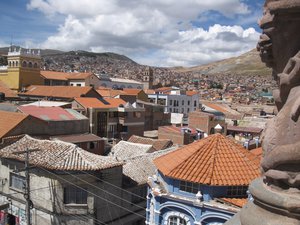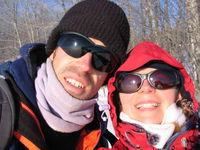Advertisement

 Potosi
Potosi
At 4070 metres, is supposedly the world's highest city. Hola Amigos...
“Potosí! Potosí! Salimos a las una” the lady shouted...
We hopped on board for a four hour bus ride to Potosí, the highest city in the world (allegedly) and a Unesco World Heritage Site. At 4070 metres above sea level, we huffed and puffed as we explored the lovely (and hilly) streets of this famous city. Little did we know that this city is not only famous for its elevation, but also its role in the history of the world‘s currency. The world’s first international coin was minted in silver here in Potosí. Our guide in The Casa Nacional de la Moneda gave us a very informative tour on the history of the mint and showed us some pretty remarkable pieces of wooden machinery from the 1700’s. The surrounding hills have one of the richest silver deposits in the world, and Spanish used slaves to mine the precious metal. Coins were minted then transported overland to the port of Arica in what was then Peru. It was then shipped to Panama, hauled overland to the Caribbean then finally shipped to Spain. Coins were produced in Potosí from 1572 to 1951, by then, copper and nickel had become

 Wooden Machinery
Wooden Machinery
In the National Mint.. La Casa de la Moneda used to make all of the world's currency at the time. the main metal in global coinage.
We also enjoyed a guided tour of the Convent of Santa Teresa, a well preserved building founded in 1685 with much charm and history of the Carmelite nuns. At 15 years of age, the second daughter of every family was destined to become a nun. Entry to the convent was a privilege and parents paid for entry with precious dowries, now on display at the museum. After the girl entered the convent, she was destined to never see the outside again, until a century or so later, when they could actually be allowed to see their parents through a lattice. Just a little bit different than our current 15 year old’s lifestyle, don’t you think?
“Sucre, Sucre! Van a Sucre?!” the lady asked us. “Si, vamos a Sucre” we replied.
“Hay un bus a Sucre en diez minutos!” she said. “Por aqui”, as she showed us where to wait.
And we were on our way to the colonial city of Sucre, the white city, the nation’s capital and also a Unesco World Heritage site. We felt quite energized in Sucre having dropped over 1000 metres in elevation – there was

 The Silver Smelt
The Silver Smelt
The silver was all melted down in dreadful conditions using mercury as an additive. African slaves and Bolivia's indigenous people lived short lives in this department. The architect at the time failed to provide proper venting.a spring in our steps for sure! With the mild climate in this lovely city, everything is done outside. In a span of a few hours we had witnessed a funeral procession down our street, a wedding photo session in the park, a collegiate march of new students and the school musical band around the plaza, and we were lucky to see the Bolivian Strong Man Contest outside the old train station! Sucre also had some good quality ‘chocolaterías’, one notable company being ‘Para Ti’, meaning, ‘For you’.
Devious Dave…
Not realizing his devious intentions one day, whilst Theresa opened the bar of 75% dark chocolate, he asked, “What was the name of that chocolate shop?” Theresa unknowingly answered, “Para Ti”.
“Para mi, gracias!” he replied, and ran off with the chocolate… Yummy!
Technically, planes don’t land at La Paz. They simply slow down a bit before coming to a stop! At 4050 metres (13480ft) above sea level, La Paz’s El Alto Airport is the highest international airport in the world. Because of the thin atmosphere at that elevation, the planes also land at about twice their sea-level velocity making for a very interesting landing… Thump!
Bolivia’s de-facto capital sits in a huge basin and is surrounded by giant peaks, the views down to the city from the dizzying heights of El Alto suburb is incredible as a colossal sprawl of red-brick buildings disappear into the smoke-filled hillsides. It was fun just to wander around La Paz and get lost in the labyrinth-like streets, although the exhaust fumes were a bit much at times. We stumbled upon hidden markets with weird and wonderful products like dried llama fetuses, bottled snake venom and various herbal remedies. We also found nice cafes with fantastic hot chocolate, a great warmer-upper in the cool mountain climate and a wonderful treatment for Theresa’s chocolate deficiency. (See above - Dave ate all the chocolate)
“Watch the leaves dance with the wind and you will find answers to your queries…”
There’s also an interesting little museum dedicated to the infamous plant,
Erythroxylum coca, more commonly known as Coca, or its chemical by-product name - cocaine. It’s just a little wee place but it was very educational… There’s a lot of history behind the controversial substance that sits in a grey area in Bolivia. It’s not legal, but it’s not entirely
illegal here either! Many people living at these high elevations chew the coca leaf, giving them the ability to work harder and longer. The Inca’s used the coca leaf as a form of currency in ancient times. If you notice wet leaves dotting the sidewalks in Bolivia, they most likely are coca leaves having been chewed, absorbed into the bloodstream through the cheeks, and after a while, spat out…
A couple of insightful poems from the Coca Museum:
The Spell…
Guard your leaves with love and when you feel pain in your heart or obscurity in your mind, bring the leaves to your mouth… (Anonymous)
The Curse of the Legend…
When the white conqueror touched the coca leaf, all he found was venom for his body and madness for his mind, and when coca tried to appease his heart, it only served to break it, like ice crystals destroy mountains… (Anonymous)
Hasta luego.
D & T
P.S. We bought more chocolate!
Advertisement
Tot: 0.056s; Tpl: 0.012s; cc: 12; qc: 23; dbt: 0.0244s; 1; m:domysql w:travelblog (10.17.0.13); sld: 1;
; mem: 1.1mb

























Kuan Yin
Karen Johnson
Potosi Mint
I first heard about the Potosi Mint when researching silver coins that had been recovered from the wreck of the Spanish ship Nuestra Senora de Atocha. The Atocha, heavily laden with gold and silver, sank off the Florida Keys in 1622. The search and subsequent discovery of the shipwreck in 1985 is an interesting story in and of itself.